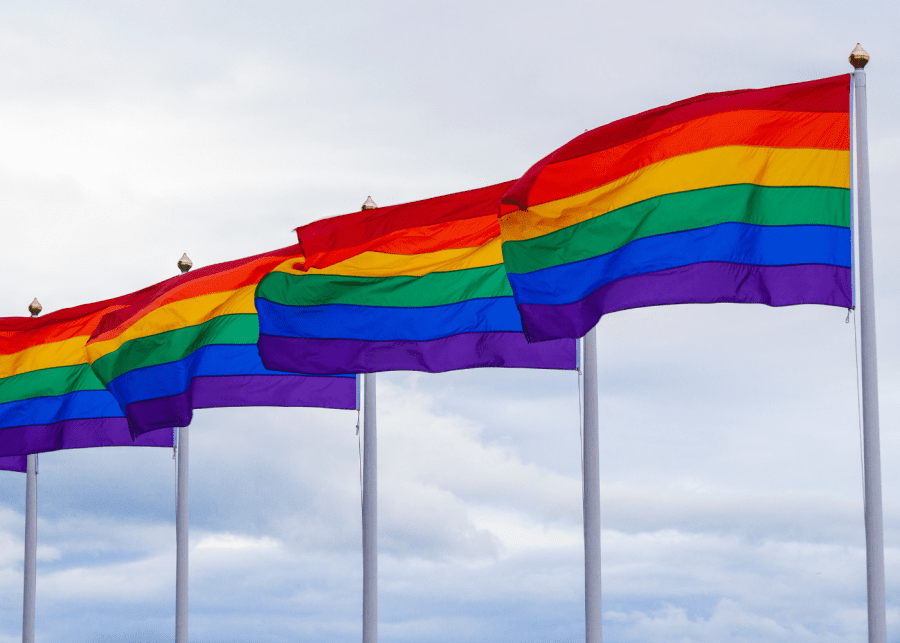
Our beginner’s guide takes you through LGBTQ+ terms commonly used in the community.
Just like any group of people, the LGBTQ+ community have their own language and terms they use to communicate who they are. To be a friend, the first step is to listen, learn and be open-minded. We’ve shared our fave LGBTQ movies and TV shows, as well as bestseller book picks for Pride Month, and now we’ve put together a list of basic LGBTQ+ terms and their definitions. Read on!
Guide to LGBTQ+ terms
1. Ally
An individual who is not LGBTQ+ but supports gender equality and equal civil rights, while advocating against homophobia, transphobia and biphobia. An ally encourages and stands up for the community.
2. Asexual
Someone who experiences no sexual attraction to others. They may not be interested in having sex with anyone, but they can still have romantic feelings for people – and be in a healthy relationship. Being asexual and aromantic are two very different things.
3. Bisexual
A man or woman who is sexually attracted to both genders.
4. Biphobia
As bisexuals are perceived to possess straight passing privilege when they’re with an opposite gender, it’s common to see people ridicule or undermine the plausibility of bisexuality. This is internalised biphobia, and it even happens within the gay community.

5. Cisgender
This means a person’s gender identity aligns with their birth sex. For instance, you were born a male and you feel like a male, so you’re a cisgender. But it doesn’t necessarily mean that you’re heterosexual.
6. Closeted
This term describes an LGBTQ+ person who has not disclosed their sexual orientation or gender identity to the wider public.
7. Drag
Drag kings and queens – some are heterosexual and cisgender – are males and females who dress like the opposite sex to perform either masculinity or femininity as a form of art.
8. Gay
A man who is sexually attracted to a man.
9. Gender non-conforming
This refers to someone who doesn’t follow traditional gender norms. They don’t dress and act masculine or feminine in order to fit into society’s default gender expression.
10. Heteronormativity
When you meet someone new, do you automatically ask if they have a partner of the opposite sex? Or when the topic of marriage comes up, do you assume it’s between a man and a woman? That’s heteronormativity. When it comes to LGBTQ+ terms, we must not forget why they’re important. The world functions in a heteronormative manner and we need to break those norms starting from language.
11. Heterosexual privilege
This term applies to the privilege and advantages that heterosexuals have in society – which LGBTQ+ people don’t.

12. Homophobia
Prejudice or discrimination against those attracted to members of the same sex.
13. Intersex
This is a general term to describe someone who is born with several variations in sex characteristics, such as genitals or chromosomes, that don’t fit the typical definitions of male or female.
14. Lesbian
A woman who is sexually attracted to a woman.
15. LGBTQIA
LGBTQIA stands for Lesbian, Gay, Bisexual, Transgender, Queer (or Questioning), Intersex, and Asexual. As the queer community gets more and more inclusive, most people simply use LGBTQ+ as an umbrella term to describe the entire community.
16. Pansexual
While bisexual is a more familiar term to describe someone who is attracted to both males and females, pansexual means that you’re attracted to all people, regardless of their biological sex, gender, or gender identity. It’s truly what’s on the inside that counts.

17. Sexual fluidity
Sexual fluidity means that your sexual orientation can change over time. For example, people who were definitively straight (or heterosexual) can feel sexually attracted to someone of the same gender, as sexual preferences aren’t set in stone.
18. Transgender
This refers to someone whose gender identity doesn’t align with their birth sex. A pre-operative (pre-op) transsexual person means someone who intends to have sex reassignment surgery (SRS) in the future, while post-op means someone who has had SRS, and non-op means someone who hasn’t had SRS and doesn’t wish to have it.
19. Transphobia
Transphobia refers to prejudice and discrimination towards trans people. If you don’t want to come across as transphobic, don’t be oblivious. Educate yourself on trans issues. Don’t question their genitals or surgery; instead, start by asking what pronoun they prefer to be called (some use gender neutral language like they/them). Also, there is a BIG difference between trans people and drag.
20. Queer
What was once perceived as a derogatory word has been reclaimed by younger generations to make it a positive LGBTQ+ term. People who identify as queer are non-heterosexual and sexually fluid.

